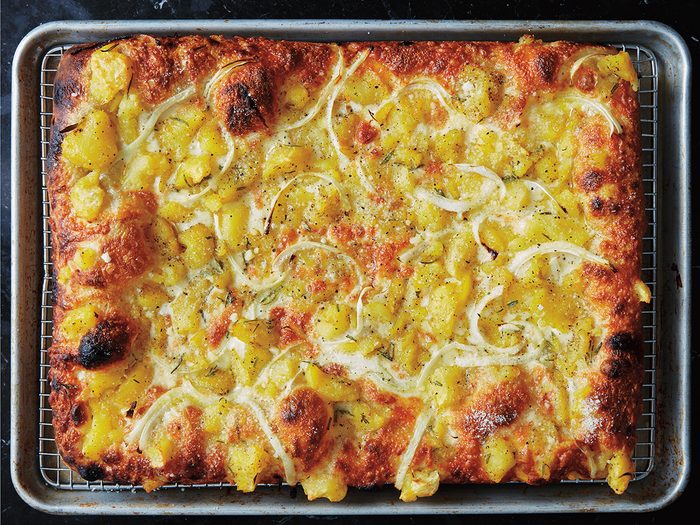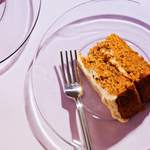This Potato-Topped Pizza Is the Ultimate Comfort Food

A recipe for pizza al taglio, excerpted from the cookbook Salad Pizza Wine by Janice Tiefenbach, Stephanie Mercier Voyer, Ryan Gray and Marley Sniatowsky
This recipe for pizza al taglio is made with potatoes—and it makes our knees weak and our hearts melt. Biting into a thick layer of rosemary-infused potatoes, cheese and dough feels like getting tucked into bed and kissed on the forehead by a loved one. It’s pure comfort.
Pizza Al Taglio
Makes 1 (12 × 15-inch)
Ingredients
Pizza Dough
- 6 1/3 cups (820 g) bread flour
- 1 1/3 cups (200 g) spelt or whole wheat flour
- 3 cups (750 ml) water, room temperature
- 1 cup (200 g) sourdough starter
- 5 tsp (25 g) fine sea salt
- 3 tbsp (45 ml) extra virgin olive oil, divided, + more oil or butter for greasing the baking sheets
- Semolina rimacinata or all-purpose flour, to dust your work surface
Pizza
- 1/2 recipe Al Taglio Pizza Dough (enough for one pizza)
- 1 lb (450 g) fingerling potatoes or 2 large Yukon gold potatoes, scrubbed
- 6 fresh rosemary sprigs (2 whole and 4 chopped), divided
- 1 tsp black peppercorns
- Extra virgin olive oil
- 5 oz (142 g) smoked provolone or smoked cheddar, sliced
- 2 balls (5.2 oz/150 g or about 1 cup) buffalo mozzarella
- 1 small yellow onion, thinly sliced (about 1 cup)
- Freshly ground black pepper 1 cup finely grated parmesan
Directions
Pizza Dough
hydrate the flours: In the bowl of a stand mixer with a hook attachment (or in a very large bowl using a rubber spatula), com- bine the flours with the water. Mix on the lowest setting until a shaggy mass forms. Turn off the mixer and let it rest for 10 minutes.
Mix or knead the dough: Add the sourdough starter and salt and continue to knead until the dough is smooth and relatively uniform, about 10 minutes. Transfer the dough to a clean surface and scrape out the mixing bowl using a dough scraper, discard- ing any dried bits. Generously oil that same bowl with 2 tbsp olive oil and place the dough inside. Cover the dough and rest it at room temperature for 30 minutes.
Fold the dough and let it rise: Starting with the edge farthest away from you, gently lift and fold the dough in half over itself. (This motion should be done confidently to stretch the dough without ever tearing it.) Rotate the bowl 90 degrees and repeat the same process until the dough has been folded on itself for a total of four times, rotating the bowl after each fold. Cover the dough and rest it at room temperature for 30 minutes. Repeat the folding process two more times, resting the dough 30 minutes at the end of each folding session. The whole process should take about 1½ hours.
Divide the dough: Transfer the dough to a lightly floured surface by flipping the bowl over and letting the dough slowly fall out.
Using a dough scraper, divide the dough in half.
Corner toward the center of the dough. Then fold the dough on itself twice as if you were folding a piece of paper to put in an envelope. Use the dough scraper to tuck the edges and create a smooth and even oval shape. Put the dough back in the same oiled container.
Cover and chill in the fridge for 2 days. During this time, the dough should proof gently, becoming lighter and springier to the touch.
It can be stored in a lightly oiled, sealed container in the fridge for up to 3 days or frozen for a few months.
When you are ready to make your pizza, proof the dough again: Grease two baking sheets with olive oil (or use butter for an extra-crispy bottom crust). Uncover the dough and coat lightly with 1 tbsp olive oil. Carefully transfer each dough portion onto the baking sheets, keeping the top side of the proofed dough facing up. Using your fingertips, gently press down on the surface of the dough to release some of the air. Cover with a damp towel and let it rest in a warm spot for at least 30 minutes and up to 3 hours. (The longer the dough proofs, the more relaxed it will become, making it easier to stretch but also more fragile.)
Stretch the dough: Once the dough has proofed, uncover it and start stretching it by lifting it from the bottom to make sure no air gets trapped underneath. Gradually and gently stretch out the corners of the dough toward the edges of the baking sheet.
Continue working with your fingertips to stretch the dough until it’s about the same size as the baking sheet. Press the dough firmly into the corners. Repeat this process with the remaining portion of dough. Your al taglio is now ready to welcome toppings.
Pizza
Temper the dough: If your dough is in the fridge, remove it and let it temper while you cook the potatoes. If it’s still proofing on the counter, leave it there.
Cook the potatoes: Bring a pot of salted water to a boil. Add the potatoes, two rosemary sprigs and the peppercorns and simmer until the potatoes are fork-tender but not falling apart, 20 minutes for fingerlings and 25–35 for larger potatoes. Remove the potatoes from the pot and let them rest for a few minutes.
Once they are cool enough to handle but still warm, peel the skins off using a small paring knife. Put the potatoes in a bowl and break them into rough chunks. Add 2 tbsp olive oil and toss to coat.
Preheat the oven: Place a rack in the upper and lower thirds of the oven. Preheat the oven to 500°F.
Stretch the dough: Once your dough is done proofing and you are ready to make your pizza, stretch it as directed in the al taglio dough recipe (p. 104 or 106).
Top the pizza: Distribute the provolone on the pizza, reaching as close to the edges as possible. Break the buffalo mozzarella into small pieces and disperse evenly. Top with the crushed potatoes, sliced onions and chopped rosemary.
Bake the pizza: Place the pizza on the bottom rack, moving it to the top halfway through, and bake until the crust is golden brown and the onions are charred in spots, 12–15 minutes.
Finish the pizza and serve: Garnish with more olive oil, freshly ground black pepper and freshly grated parmesan. Cut into squares and enjoy!

Excerpted from Salad Pizza Wine by Janice Tiefenbach, Stephanie Mercier Voyer, Ryan Gray and Marley Sniatowsky. Copyright © 2023 Janice Tiefenbach, Stephanie Mercier Voyer, Ryan Gray, and Marley Sniatowsky. Photographs by Dominique Lafond. Published by Appetite by Random House®, a division of Penguin Random House Canada Limited. Reproduced by arrangement with the Publisher. All rights reserved.
Next: Shake Up Pizza Night with this Riff on the Classic “Grandma Slice”




